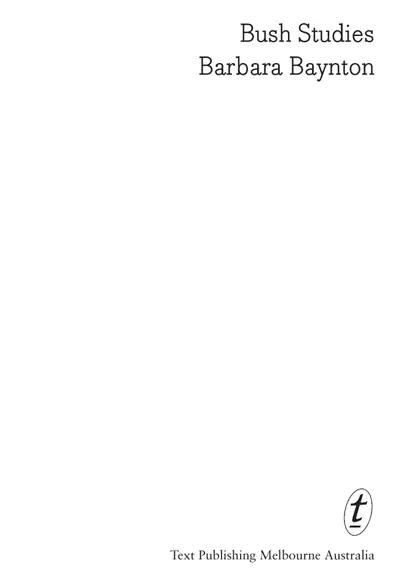Bush Studies

BARBARA BAYNTON was born in the Hunter Valley town of Scone, New South Wales, in 1857. After being educated at home Baynton worked briefly as a governess before in 1880 marrying the first of her three husbands, whom she divorced after a decade. In the 1890s, financially secure from her marriage to the retired surgeon Thomas Baynton, she began writing short stories, poetry and articles for the Bulletin. Her first tale, ‘The Tramp’, was published in 1896.
After failing to find an Australian publisher for her collection of six short stories, she visited London and in 1902 Duckworth published Bush Studies. Thomas Hardy was ‘much struck with the strength’ of Baynton’s writing. Two years later Thomas Baynton died, and Baynton spent the next years between Sydney and London. Human Toll, a novel, appeared in 1907; Cobbers, which combined Bush Studies with two new stories, was published in 1917. Baynton married Rowland George Allanson-Winn, fifth baron Headley, in 1921.
A successful businesswoman and a campaigner for women’s rights, a lover of antiques and a renowned socialite, Baynton spent her later years in Toorak, Melbourne. She was renowned for her wit and for her jewellery, particularly her collection of opals. Billy Hughes thought her a ‘remarkable woman’. She died in 1929.
HELEN GARNER lives in Melbourne. Her books include Monkey Grip, Cosmo Cosmolino, The First Stone, Joe Cinque’s Consolation and The Spare Room.
ALSO BY BARBARA BAYNTON
Human Toll
Cobbers (stories)

textclassics.com.au
textpublishing.com.au
The Text Publishing Company
Swann House
22 William Street
Melbourne Victoria 3000
Australia
Introduction copyright © Helen Garner 2012
All rights reserved. Without limiting the rights under copyright above, no part of this publication shall be reproduced, stored in or introduced into a retrieval system, or transmitted in any form or by any means (electronic, mechanical, photocopying, recording or otherwise), without the prior permission of both the copyright owner and the publisher of this book.
First published by Gerald Duckworth & Co. Ltd, London 1902
This edition published by The Text Publishing Company 2012
Cover design by WH Chong
Page design by Text
Typeset by Midland Typesetters
Printed in Australia by Griffin Press, an Accredited ISO AS/NZS 14001:2004 Environmental Management System printer
Primary print ISBN: 9781922079497
Ebook ISBN: 9781921961779
Author: Baynton, Barbara, 1857-1929.
Title: Bush studies / Barbara Baynton ; introduction by Helen Garner.
Series: Text classics.
Subjects: Frontier and pioneer life—Australia—Fiction. Women—Australia—History—19th century—Fiction. Short stories, Australian.
Other Authors/Contributors: Garner, Helen.
Dewey Number: A823.2
eBook production by Midland Typesetters, Australia
CONTENTS
Gall and Barefaced Daring
by Helen Garner
Bush Studies
A Dreamer
Squeaker’s Mate
Scrammy ’And
Billy Skywonkie
Bush Church
The Chosen Vessel

I was well into my forties when I came upon Barbara Baynton’s story ‘The Chosen Vessel’, and I have never got over it. It is shocking, and dreadful: a lone woman huddles with a tiny baby in an undefendable bush house at night, while a tramp armed with a knife slinks around it in the dark, seeking a way in. The terror Baynton evokes is elemental, sexual, unabashedly female in a way one hardly expects to read in literature of her time. Under the title ‘The Tramp’, the story appeared in the Bulletin in 1896. It was the first she ever published. She was thirty-nine.
A century later, I wrote an essay about a winter night I had spent alone in a shack on the edge of a forest. A male writer I showed it to was irritated by my anxious fantasies of marauding men, and by the mental manoeuvres I had had to perform in order to calm myself for sleep. I suppose he saw it as a piece of crude feminism. I have never got over this, either; and whenever I re-read ‘The Chosen Vessel’ I experience a deep solidarity with both its main character and its writer.
Baynton’s best-known story is probably ‘Squeaker’s Mate’. Here the bush woman is stripped of every vestige of femininity. She is childless, even ‘barren’—a tough, skilled timber-getter who smokes a pipe and always carries ‘the heavy end of the log’. Somehow this tireless worker has taken up with Squeaker, a bloke whom even the other men recognise as a whingeing bludger: to them, ‘her tolerance was one of the mysteries’. A falling tree terribly wounds her. The story is an account of a power struggle between the feckless man and the silent, devastated woman whom he leaves to lie in a corner of their shack, attended only by her dog. Every time I read it I am astonished by Baynton’s gall, the barefaced daring of the thing.
1 comment